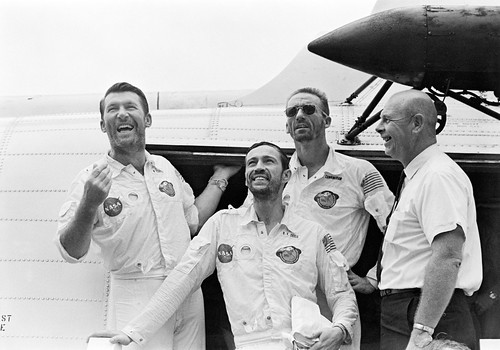
Apollo 7 lifts off. The mission’s success set the stage for Apollo 8, which orbited the Moon months later. Credit: NASA
Mission of firsts achieves 101 percent success and sets the stage for orbiting the Moon.
It’s impossible to overstate the importance of the Apollo 7 mission, which launched from Cape Canaveral, fifty years ago this month, on October 11, 1968. The launch was just 21 months after a fire during testing of the Apollo 1 Command Module claimed the lives of Command Pilot Virgil I. “Gus” Grissom, Senior Pilot Ed White, and Pilot Roger B. Chaffee.
The tragedy shook the nation, touched off Congressional investigations, and led to extensive redesigns of the Command/Service Module, flight suits, and the cabin atmosphere at launch. When commander Walter M. Schirra, senior pilot / navigator Donn F. Eisele, and pilot / systems engineer R. Walter Cunningham launched, they carried with them the future of the Apollo program.
“…Apollo 7 became very important,” Cunningham recalled in an oral history. “…if we had not had a success on Apollo 7, we really don’t know what would’ve happened to the space program.”
“It had to be perfect,” Schirra recalled in an oral history. Schirra was an accomplished fighter pilot and became the only astronaut to fly in the Mercury, Gemini, and Apollo programs.

September 1968– This is a portrait of the Apollo-Saturn 7 crew members. They are, left to right, astronauts Walter M. Schirra Jr., commander; Walter Cunningham, lunar module pilot; and Donn F. Eisele, command module pilot.
Credit: NASA
Apollo 7 was a mission of firsts. It was the first Apollo mission to launch with humans aboard, the first to test the new Block II Command/Service Module, the first launch of the massive new Saturn IB rocket with humans aboard, and the first American space mission with a live TV broadcast.
The two-stage Saturn IB was 138 ft tall, 21.4 ft in diameter, and had a gross mass of more than 1.2 million pounds. S-IB (stage 1) produced 1.6 million lbf of thrust; S-IVB (stage 2) produced 200,000 lbf. It delivered a smooth, powerful launch.
In orbit, after the S-IVB was separated from the Command/Service Module, Eisele used the Reaction Control System thrusters to turn the module around and perform important practice maneuvers that later astronauts would be required to do to rendezvous and dock with a Lunar Module. The test revealed a concern because a protective adapter panel deployed incorrectly, making the rendezvous more difficult. That led to a design change in which the panels on later missions were jettisoned, clearing the path to the Lunar Module.
During the mission, Schirra had what is likely the most famous head cold in history. The cold spread to the other astronauts and is often blamed, in part, for the somewhat testy exchanges with ground controllers at times.
There were seven live TV broadcasts from Apollo 7, the first on October 14. They were exceptionally popular with the American public for their folksy humor and informative, inside look at space travel. The astronauts showed their view out of the window, demonstrated food preparation, floated a pen in weightlessness, and described their experiences in space. The shows collectively became known as the “Wally, Walt and Donn Show,” and would win an Emmy Award from the National Academy of Television Arts and Sciences.
By all measures, Apollo 7 was considered a complete success. It demonstrated the capabilities of the Command and Service Module (CSM), the performance capabilities of mission support during a crewed mission, and Apollo’s ability to rendezvous with a lunar module.
“As a matter of fact, at the end, it was—[the] mission was described as 101% successful, and that’s because they had added a couple of detailed test objectives and things on after we were up there. So, we actually accomplished more than 100% of the objectives,” Cunningham recalled.
The success of Apollo 7 cleared the way for Apollo 8, which launched two months later, on December 21, 1968. Apollo 8 was the first manned spacecraft to orbit the Moon.
Schirra retired shortly after Apollo 7 returned to Earth. “I made a commitment to doing the things I could do within the timeframe I was willing to do it… I had 10 years of doing what I thought was appropriate to get man into space, to make man perform in space, and make the prelude to going to the Moon and back. All those things were done. I thought I had a good time,” he recalled.
View a collection of photographs of the Apollo 7 mission in our Flickr album 50 Years Ago: Apollo 7 Ends, “101% Successful”.










